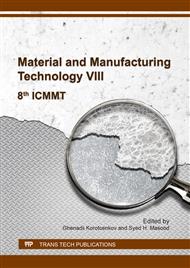p.187
p.196
p.201
p.207
p.215
p.221
p.226
p.231
p.238
Microstructure Transformation during Isothermal Aging of Biomedical Co-Cr-Mo Alloy
Abstract:
Co-Cr-Mo alloys are currently applied as major materials for orthopedic implant because of their excellent wear resistance. The main strengthening mechanism of this alloy is the transformation of γ-phase Co-Cr-Mo alloys to the ε-phase. In this study, the evolution of the microstructure of a Co-28Cr-6Mo-0.08C-0.2N alloy has been investigated during isothermal aging. Solution treatment at 1275°C for 15 hours was carried out for as-cast alloy, followed by aging treatments at 700°C and 800°C for up to 15 hours. Microstructure evaluation, XRD analysis and micro-hardness test were carried out for both as-cast and aged alloys. From XRD analysis showed that the transformation of γ-phase to ε-phase occurred during the isothermal aging. The amount of ε-phase increased with increasing aging temperature and time, while the hardness of the alloy increased with increasing the amount of ε-phase. This led to the increasing of the hardness of alloy at higher aging temperature and time. In addition, the very fine precipitation in the cobalt matrix was observed in the aged-specimens. Aging at 800°C caused the progressive formation of very fine precipitates along intra-granular striation and the matrix. It is suggested that the precipitation was took place in the grain on the dislocations and the stacking faults.
Info:
Periodical:
Pages:
215-220
Citation:
Online since:
October 2017
Authors:
Keywords:
Price:
Сopyright:
© 2017 Trans Tech Publications Ltd. All Rights Reserved
Share:
Citation:


